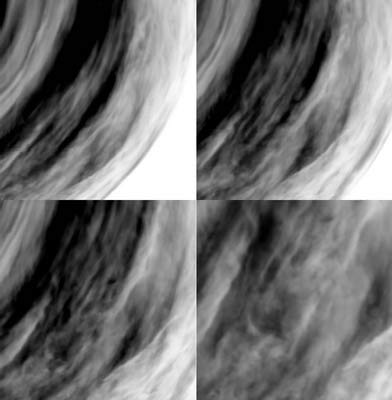Venus' Atmosphere More Chaotic Than Thought

New images from a Venus-orbiting satellite reveal the planet's atmosphere is much more dynamic than previously thought and that conditions can change in a matter of hours.
The chaotic atmosphere of Venus has long baffled scientists. Winds speeds are so high that clouds can be ferried around the entire planet in only four Earth-days in what scientists call a "super-rotation." Yet Venus, a rocky world, takes 243 Earth-days to make one complete rotation around its axis.
At the poles, all this activity sets up huge, dark, swirling vortices.
New spacecraft
European Space Agency's (ESA) Venus Express-launched in November 2005-carries instruments suited to the Venusian atmosphere that are capable of probing the dense clouds and answering some of the longstanding questions about this unsettled solar system neighbor.
"The instruments on board are based on a consolidated design studied to fly on other missions like Rosetta and Mars Express, but they have been adapted to the hot environment at Venus," said ESA researcher Giuseppe Piccioni.
Venus Express, the first dedicated mission to study the stormy atmosphere of our sister planet since the Magellan spacecraft more than 15 years ago, arrived at Venus in April 2006. The probe-for which the primary mission is set to last 486 Earth-days after orbit injection-is capable of studying the atmosphere on both the day and night sides of Venus. Similar to Earth, Venus is constantly changing what part of it faces the Sun, only more slowly. Since it takes so long for Venus to complete one rotation on its axis, the day side has a long time to heat up while the night side sits in cold darkness.
Get the Space.com Newsletter
Breaking space news, the latest updates on rocket launches, skywatching events and more!
The Sun heats up the thick Venusian atmosphere on the day side and creates convective cells where masses of warm air upwell and create local disturbances and regional winds.
Observations from the spacecraft show that at the equator, clouds are irregular and often shaped like bubbles. At mid latitudes they are more regular and streaky, running almost parallel to the direction of the atmosphere's super-rotation with speed reaching more than 300 mph (400 kilometers per hour). Closer to the poles, the clouds take on the vortex shape.
Curiously, clouds on the night side are similar, even though there's no sunlight to create the effects. Other mechanisms must be at work, such as thermal tides (a variation in atmospheric pressure due to the daily heating of the atmosphere by the sun) and gravity waves (created in the atmosphere by gravity). Features on the surface, which can't be readily observed through the thick atmosphere, likely affect wind patterns around the Venusian globe, too.
"There are outstanding questions not yet answered about Venus that we have the chance to unveil, with a bit of luck," Piccioni told SPACE.com.
Volcanic activity?
It's possible, for example, that volcanic activity on the planet's surface is affecting the atmosphere.
"We know that in the past there has been an intense volcanic activity, but it is not sure when this stopped, if it did," he said. "We [also] know that about 800 million years ago there [was] a complete resurfacing of the planet surface, possibly catastrophic, but what was the cause? What about the global atmospheric dynamics and energetic balance of the planet?"
The answers to these questions will help scientists understand why Venus, a planet thought to have been very similar to Earth long ago, is so different today. The thick atmosphere of sulfuric acid gas is about 95 times greater than Earth's and would crush a human.
The results of the data received by Venus Express also "could help us understand the Earth's evolution in the past and possibly in the future," Piccioni said.
- The Wildest Weather in the Galaxy
- Hot Discovery: Dark Vortex on Venus
- Images of Venus
Join our Space Forums to keep talking space on the latest missions, night sky and more! And if you have a news tip, correction or comment, let us know at: community@space.com.










